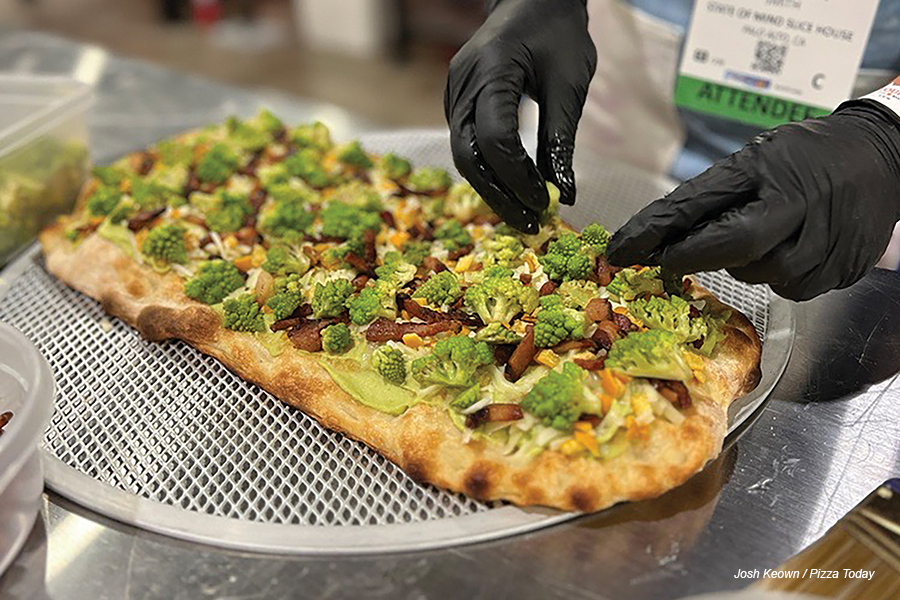Will Roman-style pizza be the 2024 pizza trend?
Back in January 2012 I used this “Man on the Street” column to predict that Roman pizza would be the next big thing. I was wrong. At the time, I was wowed by the stunning square pizzas I saw at Pizza Expo or showcased at a few brave pizzerias across the U.S. It felt like the antithesis of the stereotypical greasy slice, something that would attract the adoration of both the quick lunch crowd and gourmands alike. But as I said, I was wrong. Rome didn’t conquer in 2012, but that’s because we weren’t ready for it. As we slide into 2024 I’m digging up my prediction, dusting it off, and reconsidering the style.
I should clarify which Roman pizza I’m talking about. There are a few styles that have become associated with the city, but I’m only referring to a relatively new version. Pizza Tonda Romana is the kind of pizza you’ll find in a restaurant. It’s thin, round and flat on the edge. It looks like someone deflated a Neapolitan pizza and ironed the edges. This style isn’t seeing a rise in popularity right now. Then there’s Pizza al Metro, a long thin crispy pizza often sold in bakeries or pizza counters. It’s often sold by weight and folded into a piece of wax paper to be eaten while walking. We’re not dealing with this one either. And then there’s a curiosity called Pinsa, with a dough made from a mix of wheat flour, soy flour and rice flour. Not this one either.
The Roman Pizza on trend right now is the thick, puffy version of Pizza Al Taglio (pizza by the cut) made popular by Gabrielle Bonci when he opened Pizzarium in Rome in 2003. Unlike the Roman pizzas that came before, this version has a much higher hydration dough (at least 80 percent) with a long, cold fermentation process, and often gets topped post-bake. It’s impressive because, when done well, it’s much lighter than it looks. The texture is delicately crisp on the outside yet soft and airy on the inside. To the Instagram generation (which didn’t exist when I wrote my first Roman pizza column) it’s a visual stunner both because of its toppings and sprawling interior bubbles.
If it’s so good, why has Roman pizza taken this long to catch on in America? First we should consider that this style comes with a high level of difficulty. Roman requires techniques and ingredients different from what most American pizzerias are using. You’ll need strong flour that can hold a lot of water and a mixer that can achieve a high enough speed to incorporate and knead the ingredients. Most bakers use electric ovens and baking pans specifically made for Roman. Roman is complex enough that several schools and courses have emerged to teach the necessary techniques.
It doesn’t hurt that Roman pizza has been featured on popular TV shows like Bonci’s episode of Chef’s Table and Rob Cervoni’s win on Chopped. There’s even a Roman category at American pizza competitions. But is this really enough to resonate with the American public?
Part of me is still skeptical about Roman’s ability to become as big a trend as Neapolitan or Detroit style. It’s attractive to dough nerds and tinkerers, but might be too complex for the average pizza maker. Most of the attention being paid to it is coming from the pizza industry, not necessarily from the consumer. It’s more expensive than most other styles, especially if topped with high-end ingredients. Several Roman pizzerias have closed since my original prediction. It’s fantastic and I love it, but I’m not as convinced as I was of its broad appeal as I was 12 years ago.
Are we finally ready to accept Roman pizza al taglio into the Pantheon of American pizza? Only time will tell. I’ll probably write about it again in 2036.
SCOTT WIENER is the founder of Scott’s Pizza Tours in New York City and SliceOutHunger.org Instagram: @scottspizzatours








